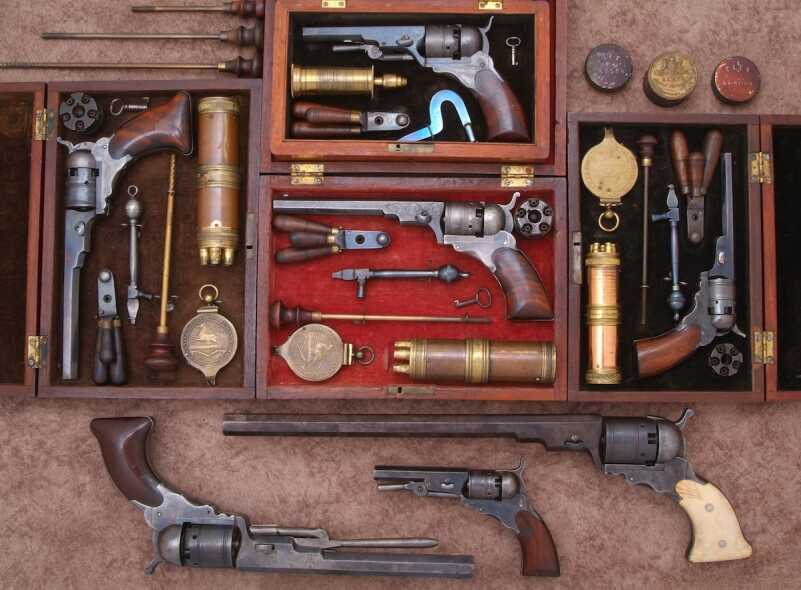
The Paterson lineage is shown beginning top center with a fine Ehlers No.2 Improved .31 caliber Pocket Model with loading lever. Below that another No. 2 Model with vine scroll engraving. To the right, a rare flat bottom grip No. 2 Model. At far right a No. 3 Model with 5-1/2 inch barrel. Across the bottom, at top a very rare No. 5 Texas Paterson with 12-inch barrel, center, a First Model New Improved Ehlers with loading lever, and a No.5 Holster Model with 7-1/2 inch barrel. (Dennis Levett collection).
To find out more, visit https://www.pietta.us/.
To purchase a Pietta reproduction revolver on GunsAmerica.com, click this link: https://www.gunsamerica.com/Search.aspx?T=pietta%20revolver.
Prior to Samuel Colt’s 1835-1836 patents for the revolver, American handguns were, for the most part, variations of European-style single shot pistols, first of the flintlock type and later the new cap-and-ball percussion lock design. There were double barrels, swivel barrels, and even multiple barreled Pepperbox pistols, but the revolver was at best a theoretical design before 1836. This is not to say that revolvers did not exist before Colt’s patent, they just didn’t work. Samuel Colt’s design did. This is the story of how it came to be.
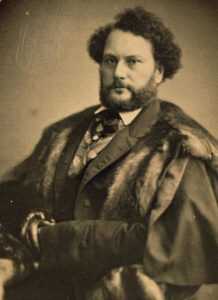
This rare photograph of Samuel Colt was taken in 1851 or 1852. He is more famously seen in a formal life size portrait painted Charles Loring Elliott in 1865, three years after Sam Colt’s death in January 1862.
The Helmsmen’s Wheel
When he was 16 years old Samuel Colt was, like almost every young 19th century boy, fascinated by tales of adventure, drawn to the allure of firearms and explosives, and dreamed of becoming a sailor, soldier, or frontiersman. The difference was that Sam wasn’t dreaming—he was serving as a seaman aboard the cargo ship Corvo during its 1830 voyage to Calcutta. It is this period from his young, adventurous life that has led many to believe that Colt saw first hand a Collier revolver while in India. The timing would have been exactly right for a handful of British soldiers to be armed with flintlock or percussion lock Collier revolvers, which were manufactured in London, England, until 1827.
While Colt claimed never to have seen a revolver prior to 1835, the fact that he perfected the one mechanical flaw that had made the Collier a failure seems to indicate otherwise. The Collier had an ineffective means of mechanically rotating the cylinder by the action of drawing the hammer to the cocked position. The original Collier flintlocks employed such a mechanism but more often it failed to align the cylinder chamber with the barrel breech requiring a manual adjustment, soon the guns were simply built to have the cylinder rotated into battery by hand. Colt pondered this mechanical conundrum and found the solution on board the Corvo: it was the windless used to raise and lower the anchor. That ratcheting device combined with the ship’s wheel got things spinning in young Colt’s mind and he envisioned a ratcheting devise that would rotate and lock the cylinder with each successive draw of the hammer. On his off-duty hours he carved a practical cylinder, arbor and hammer out of wood, the three essential pieces that would become the basis of his first firearms patent. Colt was only 16 years old when he solved a problem that had confounded three arms designers many years his senior for over a decade!
Upon returning to Boston on the Corvo in 1831 he began designing the revolver mechanism and between 1832 and 1835 had various prototypes built of both pistols and longarms assembled to his specifications by gunsmiths. The most notable was a pistol built for him by Baltimore gunsmith John Pearson, who crafted the Colt-Pearson revolver, the basis for Colt’s October 1835 English patent. This was followed by a French patent a month later and a U.S. patent on February 25, 1836. Colt knew that if a patent were filed first in the U.S. the same could not be applied for in Great Britain or France, whereas a U.S. patent could be granted regardless of whether there were foreign patents preceding it.
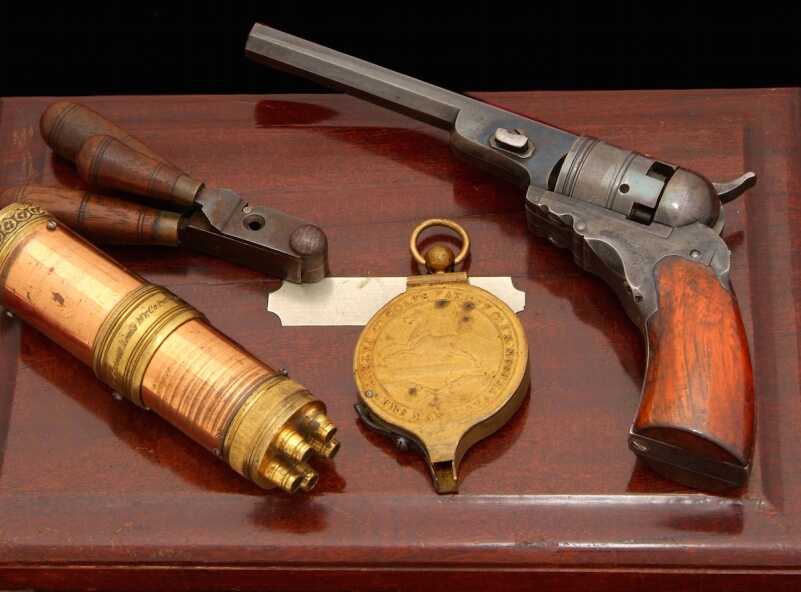
This excellent No. 1 Model on top of its handcrafted case is shown with the early small caliber two-piece Paterson powder and ball flask, bullet mold, and capper. Bear in mind, this gun would fit in the palm of an average man’s hand. (Dennis Levett collection).
Colt’s U.S. patent was later followed by a seven-year letter of extension, thus providing him with the exclusive rights to build percussion revolvers based upon the fundamentals of his design from 1836 through 1857 and total domination of the U.S. firearms market as it pertained to revolvers, whether handguns or longarms.
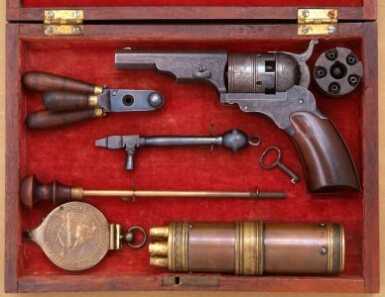
This rare, engraved No. 2 Model showing the large vine scroll style has the 3-inch barrel. Most No. 2 models had flat shouldered cylinders and no cut out in the recoil shield for capping (capping was done with the cylinder removed).
The underlying principle of Colt’s design was to enable the pawl, attached to the hammer of a percussion gun, to move as the gun was cocked, and through this movement turn the cylinder mechanically and lock it securely into battery. Colt had covered every possible interpretation of his design, and would in later years bring suit against other armsmakers for patent infringement, ensuring that only Colt would be able to legally manufacture a revolver in the United States.
However, young Sam Colt, who only was in his early twenties, did not have the money to build a manufacturing plant. He had been relying solely upon John Pearson to build guns for him, one at a time. Colt needed a factory and machinery. And that meant investors. As noted by historian and author R.L. Wilson in The Book of Colt Firearms, Sam Colt attracted the attention of several wealthy New York venture capitalists, one of who was his cousin, Dudley Selden. With their money behind him, Colt was able to establish the Patent Arms Manufacturing Company of Paterson, New Jersey, chartered by act of the Legislature of New Jersey on the 5th of March, 1836. Though Colt was “in business” he was hardly ready to begin manufacturing guns. Aside from the time necessary to set up machinery in the new facility, Colt’s prototype designs needed refining.
The first production-built Paterson arms would not leave the New Jersey factory until late in 1836, and then only in small numbers. And to the further dismay of his investors, the first products would not be the anticipated revolvers, but rather revolving rifles based on another Colt design known as the Ring Lever. A revolving rifle was an even more effective firearm and Colt was already eying the possibility of a military contract.
Five Shooters, not Six-Shooters
Early production thorough the beginning of 1837 consisted of the Paterson Revolving Rife, or the No. 1, followed by the first Paterson revolver, also designated No. 1. By the end of the year, Samuel Colt had four models in production (two rifles, two pistols) and the Patent Firearms Manufacturing Company closed the books on 1837 with nearly 1,000 rifles and pistols built. Sam Colt was finally in business; but little did he know, he was also on the fast track to going out of business.
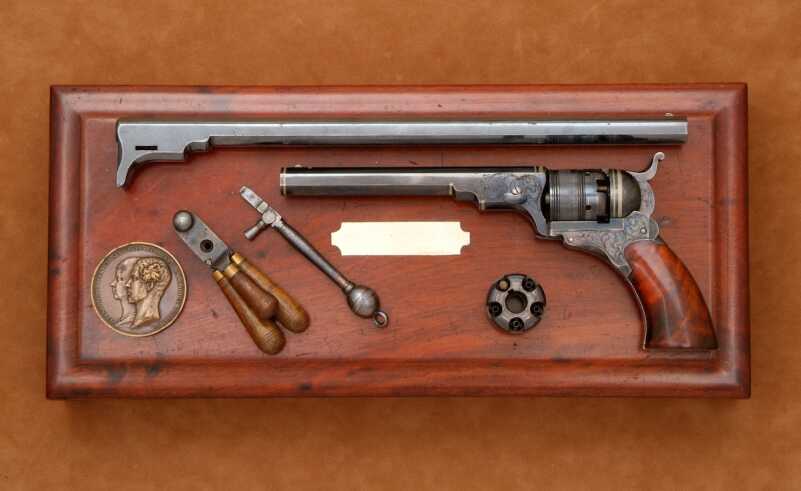
Pictured is an exceptional two barrel cased No. 2 Model. Among options offered with the No. 2 was a 12-inch barrel. A rare presentation, this example has vine scroll engraving, color casehardened frame and hammer, and German silver bands on the barrel and recoil shield. The extra 12-inch barrel was neither engraved nor silver inlayed.
At the start of 1838 Colt had three different revolvers in production: the pocket, belt and holster models; and two types of long rifles, the first cocked by a finger lever (the first Paterson firearm introduced), and the second which used a conventional hammer. Despite the generally favorable performance of Colt’s revolving rifles and pistols in the hands of early buyers, sales remained below expectations; people were weary of Colt’s revolving cylinders. America had been built on the bedrock of single shot pistols and rifles, tried and true since 1776. The U.S. government felt much the same, purchasing only small quantities of the Colt ring-lever rifles and 1839 carbines, but none of the small caliber five-shot revolvers.
The number of arms produced between 1836 and the date of Colt’s petition for bankruptcy in 1841, as well as those sold by his successor John Ehlers from late 1841 until the permanent closure of The Patent Arms Manufacturing Company in 1842, is an educated guess, although the consensus seems to be a combined total of 4,700 revolving rifles and pistols produced over a six-year period.
Between 1837 and 1842 there were four different Paterson revolvers, the No.1 or Pocket Model, also known as the Baby Paterson; the No. 2 Pocket Model; No.3 Belt Model; and the famous No.5 Holster Model. Each was progressively larger in caliber and size, but shared a similarity that was distinctive to Colt’s original design.
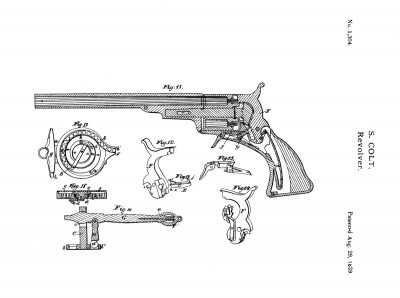
Samuel Colt’s patent drawing for the No. 5 Holster Model is dated August 29, 1839. However, this is one of two pages detailing changes to accessories for the No. 5 Models, which had been in production since 1838. This patent drawing details the Paterson capper and combination tool. (Dennis Levett collection).
The No.1 was a demure 5-shot revolver, the first production percussion handgun with a cylinder mechanically advanced to the next chamber by cocking the hammer. It was manufactured in .28 and .31 caliber versions, both comparatively small but more than adequate for a pistol one could hide in a vest pocket. Fitted with a 2-1/2 inch barrel, the gun was barely the size of a man’s hand and weighed less than 12 ounces. Even with the long 4-3/4 inch barrel, the No. 1 was easily concealed. Fewer than 500 are believed to have been built.
The No. 2 version was available in two calibers, .31 caliber and .34 caliber, with barrel lengths varying from a short 2-1/2 inch version to the long 4-3/4 inch model. Still a 5-shot pistol, the No. 2 had a bit more heft, weighing 20 ounces in .34 caliber with the long barrel. Sales were far better with production reaching around 800 examples by 1840, the year No.2 Models were first offered with an attached loading lever.
With the .31 and .34 caliber No. 3 Model, Colt introduced his first “large” revolver. Also known as the “Belt Model” it was the first transitional design which varies in configuration based upon year of manufacture. A larger gun with a medium sized frame, the No. 3 was offered in barrel lengths varying from 4 to 6 inches, and in increments of 4-1/2 inches, 4-7/16 inches, 5 inches, and 5-1/2 inches, as well as some with extra 12-inch long barrels. Later versions of the No. 3 came with new flared grips (which would appear again on the .36 caliber No. 5 Model). Approximately 900 No. 3 models were manufactured.
There was no 4th Model in the Paterson line, at least numerically; the fourth revolver was the No. 5 Holster Model. This is the gun most people see described as a Paterson, and it is indisputably the most famous. It was manufactured with and without a loading lever under the barrel. Chambered in the larger .36 caliber, it was the most powerful of the Patersons. With a full size frame and weight of 2 pounds, 8 ounces with the 7-1/2 inch barrel, this was the gun that gained fame in the hands of the Texas Rangers, and led to the model becoming known as the “Texas Paterson.” Approximately 1,000 were manufactured with barrel lengths measuring anywhere from 4-inches to 12-inches.
Only a handful of changes were implemented throughout the Paterson’s brief production history, the most obvious being the addition of loading levers, the round shoulder cylinders, and late in No.3 production, a change to larger flared grips.
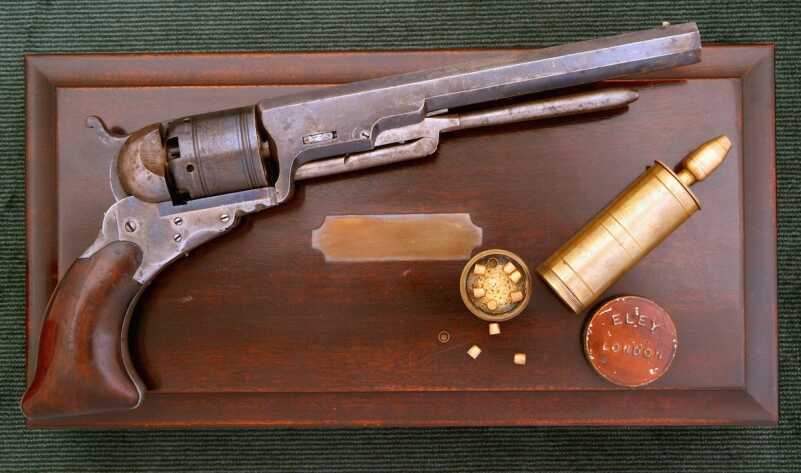
The No. 5 models were later fitted with loading levers which made it possible to reload without taking the gun apart. This cased example also has the later single nozzle power flask since the cylinder did not have to be removed to reload.
In retrospect, Sam Colt may have been the instrument of his own demise. He operated the business in a style that irritated his investors, notably cousin Dudley who disliked young Sam’s use of lavish parties and the gifting of engraved guns to government officials in hopes of gaining favor and thus orders for arms. The hoped for sales mostly failed to materialize, but established a practice Colt would use to his advantage in his second firearms venture. Recipients of Paterson pistols from Colt included Commodore John Nicholson, Col. William S. Harney (who later wrote a letter of endorsement praising Colt’s Revolving Rifles), D.E. Twiggs (Commissioner of the U.S. Patent Office), the Governor General of Cuba, Czar Nicholas I of Russia, and (so it was rumored) the President of the United States, Andrew Jackson.
In January 1838, General Thomas Jessup (to whom Colt had presented a cased pair of No. 1 Models), ordered 25 Paterson No. 3 Models and 50 No. 1 Rifles for his troops. But the biggest payoff came from the Republic of Texas, which ordered enough Paterson pistols and revolving rifles to arm the Texas Rangers and a good many officers and men of the Texas Navy. By 1842 Texas had purchased 180 Holster Model pistols, 180 Model 1839 Carbines and 100 Paterson Ring Lever Revolving Rifles.
Jack Hays and the Colt Paterson Arms
He stood five foot eight, was soft spoken, and utterly fearless. John Coffee “Jack” Jack Hays was the quintessential Texas Ranger. In the 1840s, men like Hays, Ben McCulloch, John S. Ford, and Samuel Walker forged the iconic Texas Ranger image. Despite being outnumbered by as many as ten to one, Hays and his men fought their way out of skirmishes with Mexican bandits and Comanche raiding parties for a decade. Jack Hays had stood his ground against superior numbers so many times that the Comanche called him “Devil Jack.[1]” Chief Flacco the younger, a Lipan Apache who rode with Hays in the early 1840s, called him “Red Wing”[2], and commented on his friend’s boldness; “Me and Red Wing aren’t afraid to go to hell. But, Jack isn’t afraid to go by himself.”
The Rangers, which were only established in 1823, and then unofficially, had spent the better part of 20 years armed with single shot flintlock and percussion pistols and rifles. In comparison, a seasoned Comanche warrior could fire 10 arrows in the time it took a man to reload a single shot weapon. And Rangers were almost always outnumbered. What finally gave Hays and his men the advantage was the new Colt revolving pistol. A few were already in use by the late 1830s but in May of 1844, Hays acquired enough Colt Paterson five-shot revolvers and revolving rifles from the Texas Navy to arm a small company of Rangers. He began instructing his men in pistol marksmanship with the new guns, as none of them had ever seen, let alone fired a Colt revolver. Leading from 15 to 20 men, each armed with a brace of Patersons and a carbine, Hays began patrolling the area around Walker Creek, northwest of San Antonio. It was there that the Hays, his lieutenant, Samuel Walker (later promoted to Captain), and 15 Rangers engaged a large Comanche raiding party of approximately 80 warriors. Being vastly outnumbered, such an encounter would normally have forced Hays and his men to dismount and seek cover in order to hold their position, but this time instead of dismounting and finding a defensible location, Hays and Walker led a charge against the Comanches attacking them on their flank with guns blazing. The Comanche were totally caught off guard.
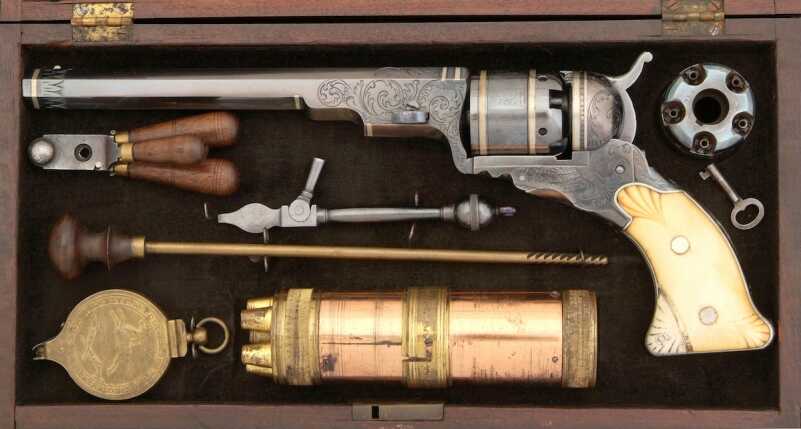
An early Texas Paterson (No. 5 Holster Model) features scroll engraving and border engraving, silver inlaid bands on the barrel, cylinder, and frame. The early models did not have the loading lever mounted under the barrel and hand to be disassembled (barrel and cylinder removed) in order or reload, or change out an empty cylinder for a loaded one. The guns always came with two cylinders. (Dennis Levett collection).
Jack Hays had studied Comanche battle tactics for years and he knew the Indians would charge, forcing the Rangers to fire their weapons, and then retreat and charge again while they were reloading. Even dividing the Rangers into two ranks, one firing, while the other reloaded, often proved ineffective. Colt’s revolvers changed all that.
Before the Paterson pistols and carbines, Rangers had relied on Spanish single shot pistols, Tennessee and Kentucky rifles or the heavy barreled Hawken rifle; the latter manufactured in St. Louis, Missouri by Jacob and Samuel Hawken. Samuel Colt’s .36 caliber, five-shot repeaters gave the Rangers an additional edge, allowing a small company of Rangers to successfully engage a numerically superior force and prevail. Armed with the Paterson revolvers and Colt’s revolving rifles Hays was able to perpetrate his plan, one that proved remarkably effective. During their encounter with the Rangers, the Comanche war party suffered heavy casualties, including the loss of their leader Chief Yellow Wolf. The retreating war party was mystified by the Ranger’s ability to continue firing without having to reload after each shot; the Comanche had never seen a revolving rifle or pistol before. This pivotal battle fought on June 8, 1844, would change the history of Indian warfare on the Western Frontier and make Samuel Colt’s revolver legendary.
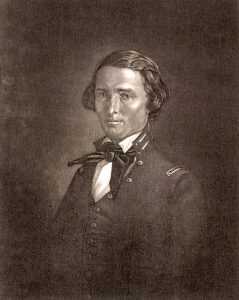
Texas Ranger Captain Samuel Walker was one of Sam Colt’s greatest supporters and was instrumental in Colt’s return to the arms market in 1847.
Despite it increased firepower, the Paterson was not a perfect weapon. The guns had several notable drawbacks for military use. Although 7-1/2 inch, 9-inch and even 12-inch barrels were available, in addition to shorter 4-5/8 inch barrels, the Paterson used a small powder charge and the .36 caliber round ball had limited effect unless the shot was well placed, which Hays’ men were capable of. The Paterson’s advantage of multiple shots greatly outweighed its caliber. The Colt revolver’s single biggest problem was that it could not be quickly reloaded in battle since the gun had to be partially disassembled to reload. This was corrected with the addition of a loading lever on later 5th Model Patersons. The first revolvers used by the Texans did not have loading levers, thus Hays had his men armed with at least one pair of revolvers, providing each man with a minimum of 10 shots.
In a letter to Sam Colt, Ranger Captain Samuel Walker praised the Paterson and voiced his hopes for Colt to build an even better revolver. “The Texans who have learned their value by practical experience, their confidence in them is unbounded, so much so that they are willing to engage four times their number…Without your Pistols we would not have had the confidence to have undertaken such daring adventures. With improvements I think they can be rendered the most perfect weapon in the World for light mounted troops which is the only efficient troops that can be placed upon our extensive Frontier to keep the various warlike tribes of Indians & marauding Mexicans in subjection. The people throughout Texas are anxious to procure your pistols & I doubt not you would find sale for a large number at this time.”
Unfortunately, by the time Walker wrote to Colt, he had gone bankrupt and was out of business, having been forced into receivership in 1842 by John Ehlers, who purchased the company’s assets at auction. Five years later, with the help of Captain Samuel Walker, Colt got a second chance, receiving a contract to build 1,000 guns for the Texas Rangers, which had been organized into the U.S.M.R. (United States Mounted Rifles) to defend the State of Texas during the Mexican-American War. The .44 caliber revolvers he built for the Texas Rangers put Samuel Colt back on the road to prosperity and led to the forming of the Colt’s Patent Fire-Arms Manufacturing Co. of Hartford, Connecticut in 1855. By the start of the American Civil War in 1861, Colt had become the most successful and influential armsmaker in the United States. A success he owed, to a great extent, to Jack Hays, Samuel Walker and the Texas Rangers.
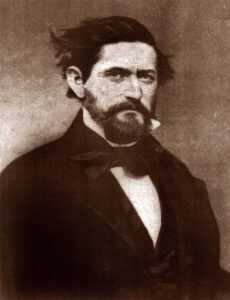
Capt. John Coffee “Jack” Hays was one of the original Texas Rangers and the first to make use of the new Colt’s Paterson revolvers and carbines in combat with Comanche warriors in 1844.
Hays after Texas
Promoted to the rank of Colonel in 1846, Jack Hays was placed in command of the 1st Regiment of Texas Mounted Riflemen (U.S.M.R.) in support of General Zachary Taylor, and later General Winfield Scott during the Mexican War. Hays and fellow Ranger Captain Samuel Walker were to play a pivotal role in America’s defeat of Mexico and in securing the Texas Republic’s borders. Tragically, Walker who had been instrumental in Samuel Colt’s development of the .44 caliber Model 1847 Holster Pistol was killed in battle on October 9, 1847 in Huamantla, Tlaxcala, Mexico. In his honor, Colt renamed the Model 1847 Holster Pistol the Walker Colt.
Jack Hays spent 13 years as a Texas Ranger before retiring and leaving Texas. In 1848, the grateful citizens of Texas showed their gratitude by naming Hays County in his honor. In 1849 Hays headed west following the gold rush to California where a year later he was elected as the first Sheriff of San Francisco. In less than two years he made a name for himself bringing law and order to a city that had only been ruled by vigilantly law before he arrived. By 1852 that had all changed.
Before he became a Texas Ranger, Jack Hays had been land surveyor, and in 1853 he accepted an appointment from President Franklin Pierce as the U. S. Surveyor General for California, where he would play a significant a role in the founding of Oakland, California. Never having sustained a serious wound in all his years as a Texas Ranger and frontier lawman, on April 25, 1883 John Coffee “Jack” Hays died peacefully at his home in Piedmont, California, at the age of 66. Even though he was a Tennessean by birth and was buried in the Mountain View Cemetery in Oakland, California, some say he was the greatest Texas Ranger that ever lived. A statute of Hays stands in front of Hays County Courthouse in San Marcos, Texas. Perhaps one should also have been erected in Hartford, Connecticut, in front of the Colt factory, for without Jack Hays, the future of Samuel Colt’s revolvers might have otherwise ended in 1842.
Recreating the Paterson Revolvers
In the long history of Paterson reproductions, first created by A. Uberti and then by F.lli Pietta, there have only been three versions manufactured. Uberti offered two models of the 7-1/2 inch barrel length Texas Paterson Model, the first without loading lever, and the later No. 5 Holster Model with loading lever. Both are now only available on the secondary market. Pietta manufactures both standard and deluxe versions of the early (square shouldered cylinder) models with a 9-inch barrel and this remains the only Paterson revolver currently in production.
Colt Blackpowder Arms was the first American maker to bring back an authentic factory marked Paterson, which was produced in a limited edition from 1998 to 2002. The rarest Paterson commemoratives thus far have been sold by America Remembers; two Ehler’s-style Belt Models with 3-1/2 inch barrels and loading levers, offered in limited editions of 100 guns, (2001 and 2004). The last was a cased two-barrel set, with 4-5/8 and 12 inch barrels. This was the most authentic cased model and accessory set America Remembers ever produced. It was the first Paterson reproduction with a 12-inch and 4-5/8 inch barrel, correct Colt capper, tools, and an authentically styled and functioning 2-piece, 5-round powder and ball flask. The frame and barrels were engraved in an original vine scroll pattern with silver accent bands. The gun was also cased in a period-style walnut presentation box with the correct spring devices for securing accessories, a wooden spool for the spare cylinder, and brass pins to secure the gun and extra barrel.
The guns were built on 3rd Generation Colt Blackpowder Arms Paterson frames with the hand engraving and barrels done by Conrad Anderson, who also handcrafted the authentic two-piece powder and ball flasks. The guns were finished in an original c.1840’s Colt fire blue (later Carbonia blue by Doug Turnbull), with a slightly antiqued appearance on the earlier examples. The presentation case and wooden handled accessories were all handmade by Pennsylvania future maker Duncan Everhart. The cased set was the most limited edition in the company’s history with only 20 having been built with a retail price of $5,995 each. Today they are all in private collections and few if any have ever appeared on the secondary market.
If you are looking for something a little more reasonably priced, Pietta produces a reproduction variant of the Paterson that can be had for around $600 from sellers such as Dixie Gun Works and Taylor’s & Co. These reproductions offer today’s cowboys a chance to own their own version of this interesting design without breaking the bank.
- [1] The Comanche name for Hays was one word, which roughly translated into: “man-it-is-very-bad-luck-to-get-in-fight-with-because-devils-help-him.”
- [2] Another historical reference has Chief Flacco naming Hays “Blue Wing.”
- Sources: Texas Ranger Hall of Fame; Legends of Texas by J.D. Murrah; John Coffee “Jack” Hays by Lee Paul; Ambush and Siege at Paint Rock by Wayne R. Austerman [Wild West magazine April 2010]; Colt Single Action – From Patersons to Peacemakers by Dennis Adler [2006 Chartwell Books], Colt 175 Years by Dennis Adler [2012 Barnes & Noble] and The Book of Colt Firearms by R.L. Wilson, [Blue Book Publications].
To find out more, visit https://www.pietta.us/.
To purchase a Pietta reproduction revolver on GunsAmerica.com, click this link: https://www.gunsamerica.com/Search.aspx?T=pietta%20revolver.

Thanks for the history. Enjoyed reading about Colt’s up and downs. Info about Texas Rangers was really interesting. Well written.
Very well written , love the history , learned more things about the Texas Rangers in this article than I’ve read in years ! Keep the stories coming !
I’m writing a biography of Commodore John B. Nicolson, listed as one of the military recipients of a revolver from Samuel Colt. The commodore left Boston May 20th 1837 in command of the US frigate Independence on his way to St. Petersburg to deliver the new U.S. Minister to the court of Czar Nicholas I. Commodore Nicolson had dinner with the czar at the Winter Palace on at least one occasion and was in his presence again a couple of additional times during the two-week stay. I can imagine Nicolson presenting the czar with one of Colt’s No. 1 model Paterson revolvers.
Excellent and Outstanding really this article deserves a lot more compliments loved the blog and the writing skills.
They are hard to come by now. Got a Pietta (Texas Paterson) some years ago as it is the only revolver allowed at “Rendezvous”. Anyhow, they can be a “b___h to dissemble and reassemble the first couple times. Also, you will soon see why that was Colts’ last design without a trigger guard when you shoot it one handed. Still, my favorite of all my other BP revolvers. ( 2 Walkers, 1-3rd model Dragoon, 1-49, 1-51, 3-60’s, 1-62, 1-61, 2-L&R’s, and a S&B. ASM’s, Piettas, Uberti, and one defarbed Spanish made one.
Excellent! Well written and well illustrated. The only thing I missed were pictures of the long rifles and carbines.